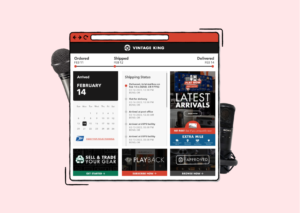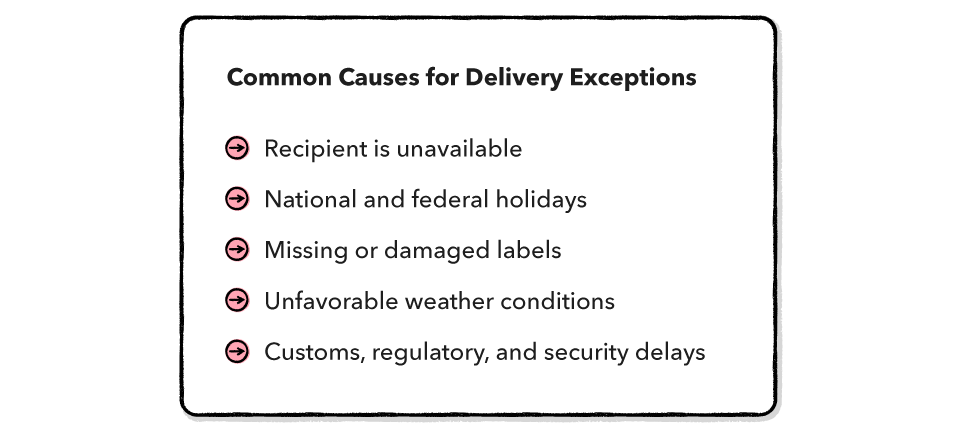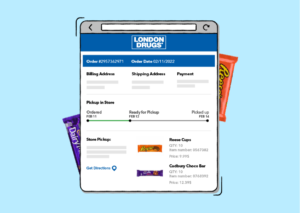
Vintage King Combats Supply Chain Issues with Proactive Communication
For nearly three decades, Vintage King personnel has been committed to equipping customers with the very best audio equipment, advice, and personal services across the globe.
Shipping, Tracking & Notifications
Boost customer experience and reduce support tickets
Realtime order and shipment tracking
Proactive order and shipping notifications
AI-Enhanced Discounted Labels
Predictive pre-purchase estimated delivery dates
Self-Serivce branded order tracking
Effortless experience delivered
Identify and Resolve Order Issues
Realtime order and shipment tracking
Make returns profitable and delight customers
Flexibility to define any return destinations & conditions
Simplify returns for your customers and team
Incentivize exchanges over returns
Returns management made easy for your team
Returns management made easy for your team
Easy claims and smart upsells
Understand why your customers are returning
In-Store & Curbside Pickup
Unify the online and the in-store experience
Hassle-free pickup experience for customers
In-Store dashboard to keep operations streamlined
In-Store and Online orders unified
Drive foot-traffic to your stores
Shipping, Tracking & Notifications
Boost customer experience and reduce support tickets
Realtime order and shipment tracking
Proactive order and shipping notifications
AI-Enhanced Discounted Labels
Predictive pre-purchase estimated delivery dates
Self-Serivce branded order tracking
Effortless experience delivered
Identify and Resolve Order Issues
Realtime order and shipment tracking
Make returns profitable and delight customers
Flexibility to define any return destinations & conditions
Simplify returns for your customers and team
Incentivize exchanges over returns
Returns management made easy for your team
Returns management made easy for your team
Understand why your customers are returning
In-Store & Curbside Pickup
Unify the online and the in-store experience
Hassle-free pickup experience for customers
In-Store Dashboard to keep operations streamlined
In-Store and Online orders unified
Drive foot-traffic to your stores
Boost customer experience and reduce support tickets
Realtime order and shipment tracking
Proactive order and shipping notifications
AI-Enhanced Discounted Labels
Predictive pre-purchase estimated delivery dates
Self-Serivce branded order tracking
Effortless experience delivered
Make returns profitable and delight customers
Flexibility to define any return destinations & conditions
Simplify returns for your customers and team
Incentivize exchanges over returns
Returns management made easy for your team
Equip your team for precise return checks.
Easy claims and smart upsells
Understand why your customers are returning
Unify the online and the in-store experience
Hassle-free pickup experience for customers
In-Store Dashboard to keep operations streamlined
In-Store and Online orders unified
Drive foot-traffic to your stores
Find the answer to all your questions
Take a step by step trip through our functionality to see how we can improve your ecommerce processes.
Explore the most comon questions about WeSupply
Calculate the ROI that WeSupply can bring you
Read actionable articles on how to optimize your post-purchase experience and decrease support tickets
Get inspired by stories of how our customers implemented an effortless post-purchase experience
Wondering if WeSupply is a good fit for you? Read through our use cases to see how we can help you increase conversion & improve CX!
A Deep Dive into Top Companies' Order Tracking & Returns Strategy
Find the answer to all your questions
Explore the most comon questions about WeSupply
Calculate the ROI that WeSupply can bring you
Request a no strings attached review of your current shopping experience and missed conversion opportunities
Take a step by step trip through our functionality to see how we can improve your ecommerce processes.
Read actionable articles on how to optimize your post-purchase experience and decrease support tickets
Get inspired by stories of how our customers implemented an effortless post-purchase experience
A Deep Dive into Top Companies' Order Tracking & Returns Strategy
Wondering if WeSupply is a good fit for you? Read through our use cases to see how we can help you increase conversion & improve CX!
Managing returns has never been easier! Check out the returns management best practices below to learn how to simplify the entire process.

Once upon a time, there was a perfect world where all products were always flawless, and not a consumer would be dissatisfied with their order, asking for a return, exchange, or refund.
Unfortunately, real life is far from such a fairy tale, and eCommerce business owners have to deal with all sorts of return reasons. Truth is that items can get damaged or lost during delivery, or the product might not meet a customer’s expectations due to incorrect size, color, and so on.
Don’t lose all faith just yet. There is no one way to handle returns, but there are surely things you can do to improve the entire process. With the right tools and procedures in place, you can facilitate returns for your customers and staff, keep your order fulfillment software up-to-date, and much more. As long as you manage your returns effectively, everything will go smoothly!
In this article, we’ll discuss some of the returns management best practices you need to keep in mind when working on your returns process, but first:
It’s like asking why elephants can’t jump or why octopuses have three hearts (it’s true, by the way). Well, returns management matters for a lot of reasons, actually.
Namely, at least 30% of products ordered online are returned due to a variety of reasons, such as items that look different than what was displayed online or damaged goods (often during transportation).
Considering the high volume of products being returned, you need to be as cost-effective and efficient as possible when handling returns.
Besides, when a customer is having a good time despite the return itself, they are more likely to want to make another purchase from you in the future. On the other hand, if the returns process resembles a bumpy road rather than a smooth sail, it’s less likely that they’ll come back running to you.

People will want to spend more on your business if you’re creating the right shopping and post-purchase experience for them, and that includes returns as well! In fact, having an exceptional returns process makes shoppers feel confident in spending money with you.
You can achieve this by enabling them to track their returns and keep an eye on refund statuses in real-time, allowing them to be autonomous during the returns process, and offering multiple options for flexibility. These little things will make a huge difference, and we’ll discuss every one of them in the paragraphs below.

The returns process can be a tedious one, and poor management isn’t helping at all. In fact, it might be hindering the productivity and performance of your customer service team. The point of effective returns management is to decrease the workload while increasing customer satisfaction every time a customer returns something.
Whether you decide to process returns automatically or manually (or both), it’s up to you, but you need to be quick, error-free, and empathetic with your customers, and with some great practices in place, you can do so.
Below are 6 best practices to help your online store level up its reverse logistics for an improved customer experience!
Think about this:
The time your customers waste on calls with your support representatives or emailing back and forth, they could be spending on your online shop (and even your physical store, if that’s the case).
Ditch the time-consuming operations involving your customer support team and enable your customers to handle return requests themselves.
Over 60% of U.S. consumers prefer automated self-service for customer service tasks that are simple. Keeping this in mind, you’ll be doing everyone a favor by implementing a self-service returns center.
Besides, customers are also looking for more convenient ways to deal with their returns. For instance, no one wants to wait in line to return their items. That’s one of the many reasons why retailers should provide a variety of options such as home pickup, multiple drop-off locations, and other convenient alternatives you can possibly think of.
Setting up an online return portal can simplify the return merchandise authorization procedure for both consumers and staff. You can also ease the process on your customers’ end by generating return shipping labels automatically within your RMA platform.
Check out our 6 tips to implement self-service returns in 2023!
Speed matters.
The faster things move, the more you’ll learn about what it takes to be successful in business and run your own organization effectively— and often repetition helps!
It’s in your interest to handle returns quickly so you can sell the products again or simply to get them out of the system to make room for improvement. Besides, when customers get their money back, a replacement, or exchange product fast enough, they are much happier with your brand than otherwise.
And for the returns process to take less time, from the moment the customer sends in the return request until you completed the transaction, you need to consider the following:
You need to be straightforward in your return policy. Set clear rules, let people know the return window for each category/item/season, depending on your return logics (if your current platform allows you to create separate logics).
We all love immediate gratification, let’s be real. And your customers do too! Why let them wait for days or even weeks in a row to get their money back when you could instantly offer them online store credit right upon return approval! This way they can make another purchase from your online store, increasing the customer lifetime value.
What do we want? To return the product!
When do we want this? Right now.
You also need to consider the fact that maybe some of your customers would rather go directly to your brick-and-mortar store to return the product and receive their money back upfront.
They’re impatient and want things done right here and now, so you need to meet them halfway as well. If your returns management system allows you, make sure you offer multiple return locations, including in-store returns, drop-off points, or both.

On average, retailers have a fixed 14-day return window for most orders. However, if you’re shipping your products overseas, or if there’s been a delay in shipping due to events like, you know, a global emergency situation, you might consider extending the return period.

Moreover, you may be offering free returns to your local customers, but you might want to ask for return or restocking fees when it comes to international orders or other special cases. For that, you need a system that enables you to automatically approve and sort returns by specific and clear return rules and logics. Going through all of your requests manually would take too much of your team’s precious time, so having these repetitive tasks on autopilot is a must!
Besides, automating your returns will also help you improve your order and inventory management system. If your seasonal products are returned in time for possible resale, having an automated return management system will help you get your returned products out there faster and just on schedule for a future repurchase.
If you’ve settled once and for all on the type of software you’re looking for, it’s time to understand the main features that turn an average returns platform into the perfect one for your eCommerce business!
Although there’s no fairy tale, product dispositions will always tell us the story behind any return. It’s important since the condition of returned items when they arrive at the return location normally influences whether or not they are restocked, prepped for resale, liquidated, or otherwise disposed of.
And for that, you need to separate the physical process from the accounting process but still have an overview of both these aspects. Another thing you should consider doing is making a clear distinction between return reasons and physical dispositions. The first one describes the reason why the customer returned the item, whereas the latter refers to the physical state of the returned goods.
Unfortunately, product dispositions are like the underdogs in the story of returns management, possibly being the most under-recorded information related to returns. However, if collected and properly analyzed, they can offer you incredibly valuable information.
For instance:
Keep an eye on your product dispositions, and you’ll surely see an improvement in your returns management process!
Remember that the feedback that matters often comes from the people who interact with your product or service the most. You might not work with your products or services on a daily or even weekly basis, then you clearly don’t have an understanding of what goes behind the scenes as your staff or often customers.
Make sure you’re actively listening to your employees and provide them with the resources they need to do their work right and report any potential issues that will save you precious resources in the long run.
This will also enable you to make informed decisions quickly and solve anything more effectively, so trust your people and pay attention to the little details!

People care about the environment, as they should. As a matter of fact, 73% of Gen Z consumers are willing to pay extra for sustainable products. Moreover, a recent report says that 75% of Gen Z respondents said they wanted to see that brands were ensuring employee and consumer safety.
And Gen Z consumers are not alone in this.
Besides, considering that a significant part of online shoppers is Gen Z or Millennials, you might want to consider catering to these audiences in a way that makes you stand out from your competition.

To do that, you can start by making your returns as environmentally friendly as you can.
Especially in recent years, retailers have come under fire for the mismanagement of returned products. Clothes retailers, especially, have faced criticism for irresponsibly managing returns by sending them to landfills.
The best practice is to resale returned products whenever possible. If not, you can consider other effective and eco-friendly options like recycling and upcycling materials, and encouraging consumers to take action as well, by reusing or donating products to charitable organizations, or at least by disposing of them in special locations.
If you want to take care of these processes on your end, you might want to consider investing in a platform that enables you to have intelligent dispositions. This will help you better organize returned items and send them to the right location directly from your customer.

What if you could track returned items, monitor return reasons, and get valuable feedback from your customer to decrease the overall number of returns in the future, all of these using one platform?
Well, you can! WeSupply enables you to keep an eye on what matters, improve the customer experience and take a load off your customer service team by:
We can also help with combating return abuse and fraud, but that’s a story for another time.
Until then, feel free to watch our Returns demo and see our platform in action!
Want to implement your own self-service returns center?
Get our free guide “How to Implement Self-Service Returns” to learn more!
Learn how automated
returns work in WeSupply!
Our shipping and logistics experts will guide you through the product and analyze how WeSupply best fits your eCommerce needs.

For nearly three decades, Vintage King personnel has been committed to equipping customers with the very best audio equipment, advice, and personal services across the globe.

What is return abuse and how can you handle it? Read this article to find out what are some tell-tale signs and how to steer clear of them.

Check out this list with the top 7 returns management software for eCommerce businesses and decide which one fits your needs the best.

WeSupply developed a custom solution (now fully available for everyone) that detects the originating warehouse for each product automatically and, when a return is created for multiple products, and it generates multiple labels based on each product’s return warehouse.

Return labels are a fundamental part of the returns process, but what is the most effective way to generate them? Learn in this article!

By Working with Kibo and SalesForce, WeSupply helps London Drugs improve the buyer’s experiences across all touchpoints by providing a branded tracking interface and proactive SMS and email alerts from the time a customer presses ‘buy’ until the package is delivered.

Atmos found what they were looking for in WeSupply’s fully customizable tracking page. With our page Atmos goes beyond offering their customers valuable shipping and returns information.

Like most online retailers, Snipes is no exception. Jako’s
support team were constantly fielding “Where’s my order?” phone calls from
customers – sometimes the same day the item was purchased!

Don’t let international eCommerce challenges stop you from growing. Here you’ll find 5 tips for improving the international returns process.